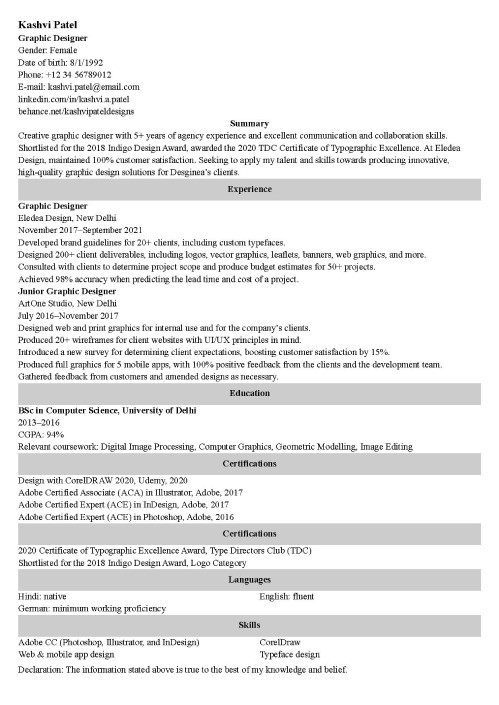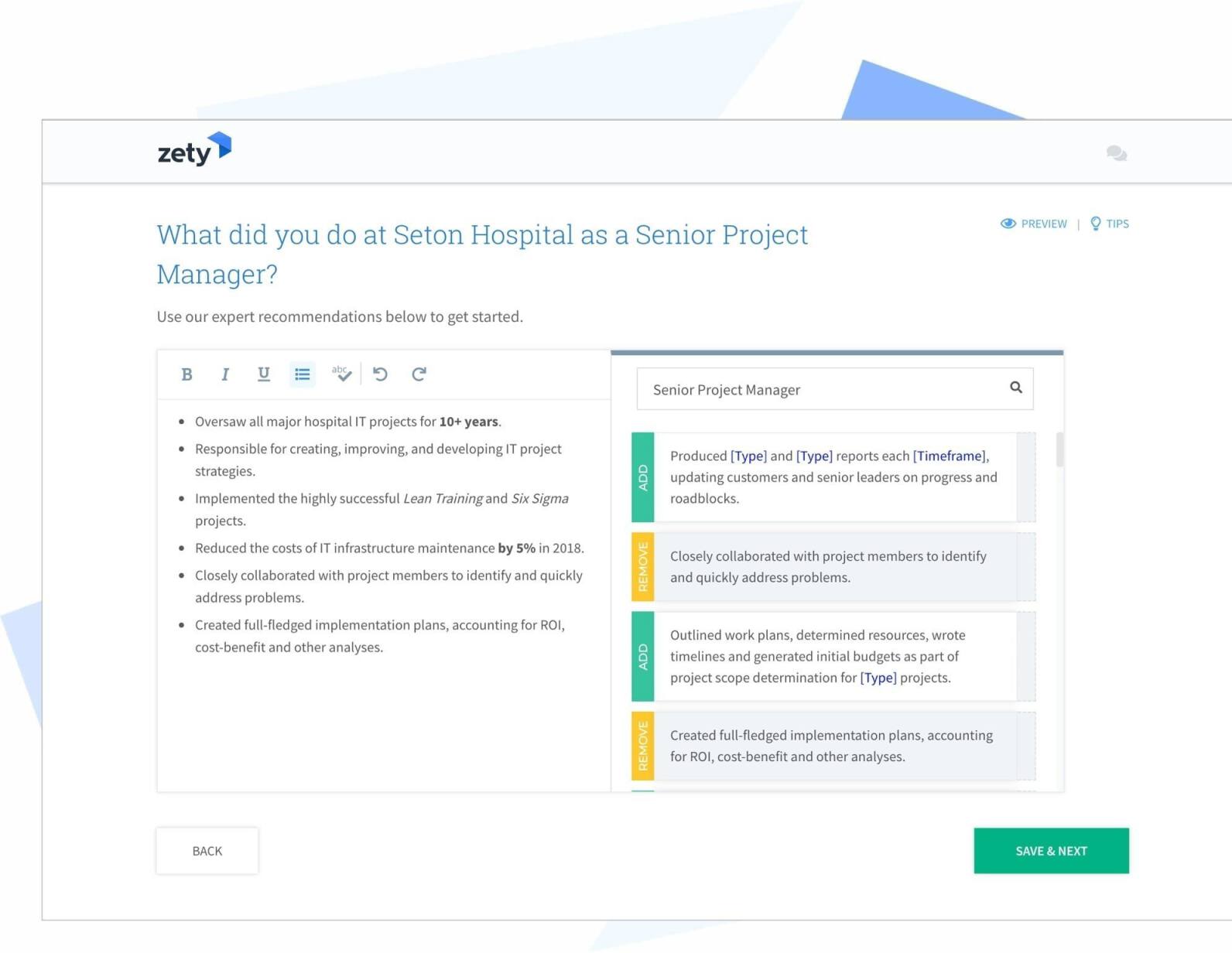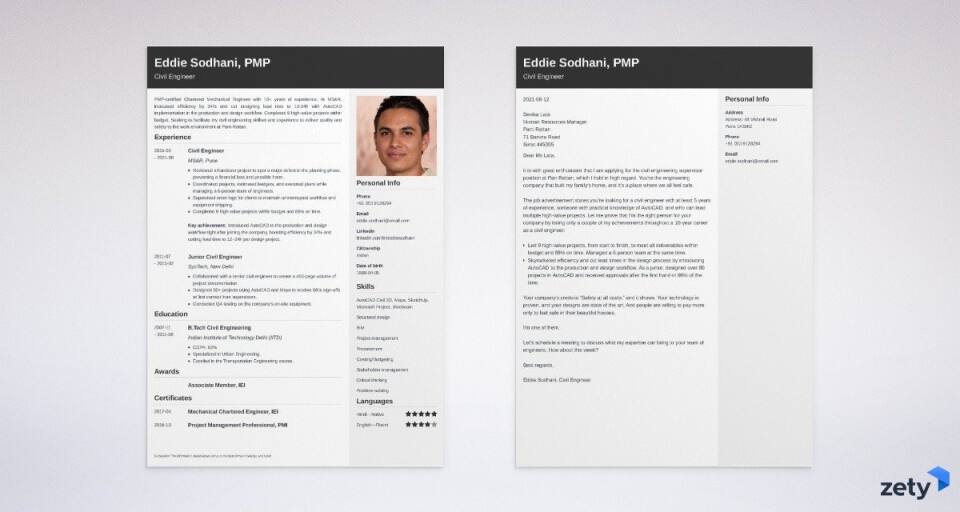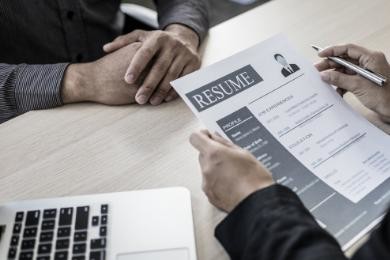How to Write a Resume for a Job: See a Good Sample & Guide
Create Your Resume NowShowing your skills, highlighting your personality, proving you’re a good fit for the job, impressing the recruiter, and landing you an interview at your dream company—
That’s a lot to expect from one A4 piece of paper…
But that’s exactly what your resume needs to do. Seems impossible, doesn’t it?
Don’t worry—
It’s far easier than it seems, and I'll teach you all the tricks of the trade and find out how to write a resume the right way.
I will show you:
- How to write a resume that recruiters will love, with plenty of examples.
- How to write a resume summary, work experience, and other sections, step-by-step.
- Ways to highlight your skills and achievements on your professional resume.
Want to save time and have your resume ready in 5 minutes? Try our resume builder. It’s fast and easy to use. Plus, you’ll get ready-made content to add with one click. See 20+ resume templates and create your resume here.
Sample resume made with our builder—See more resume examples here.
Ready to get started?
First up, let’s take a look at a job-winning sample resume:
Sample—How to Write a Resume
Kashvi Patel
Graphic Designer
Personal Info
Gender: Female
Date of birth: 8/1/1992
Phone: +12 34 56789012
E-mail: kashvi.patel@email.com
linkedin.com/in/kashvi.a.patel
behance.net/kashvipateldesigns
Summary
Creative graphic designer with 5+ years of agency experience and excellent communication and collaboration skills. Shortlisted for the 2018 Indigo Design Award, awarded the 2020 TDC Certificate of Typographic Excellence. At Eledea Design, maintained 100% customer satisfaction. Seeking to apply my talent and skills towards producing innovative, high-quality graphic design solutions for Desginea’s clients.
Experience
Graphic Designer
Eledea Design, New Delhi
November 2017–September 2021
- Developed brand guidelines for 20+ clients, including custom typefaces.
- Designed 200+ client deliverables, including logos, vector graphics, leaflets, banners, web graphics, and more.
- Consulted with clients to determine project scope and produce budget estimates for 50+ projects.
- Achieved 98% accuracy when predicting the lead time and cost of a project.
Key achievements:
- Maintained 100% customer satisfaction during almost 4 years on the job.
- Received the 2020 Certificate of Typographic Excellence from TDC for a typeface design project.
Junior Graphic Designer
ArtOne Studio, New Delhi
July 2016–November 2017
- Designed web and print graphics for internal use and for the company’s clients.
- Produced 20+ wireframes for client websites with UI/UX principles in mind.
- Introduced a new survey for determining client expectations, boosting customer satisfaction by 15%.
- Produced full graphics for 5 mobile apps, with 100% positive feedback from the clients and the development team.
- Gathered feedback from customers and amended designs as necessary.
Education
BSc in Computer Science, University of Delhi
2013–2016
- CGPA: 94%
- Relevant coursework: Digital Image Processing, Computer Graphics, Geometric Modelling, Image Editing
Certifications
- Design with CorelDRAW 2020, Udemy, 2020
- Adobe Certified Associate (ACA) in Illustrator, Adobe, 2017
- Adobe Certified Expert (ACE) in InDesign, Adobe, 2017
- Adobe Certified Expert (ACE) in Photoshop, Adobe, 2016
Awards
- 2020 Certificate of Typographic Excellence Award, Type Directors Club (TDC)
- Shortlisted for the 2018 Indigo Design Award, Logo Category
Languages
- Hindi: native
- English: fluent
- German: minimum working proficiency
Skills
- Adobe CC (Photoshop, Illustrator, and InDesign)
- CorelDraw
- Web & mobile app design
- Typeface design
- Scheduling and budgets
- UI/UX design principles
- Problem-solving
- Communication
- Colour theory
- Collaboration
Declaration: The information stated above is true to the best of my knowledge and belief.
Well—
I'm sure Kashvi will have more than one job offer to choose from with a resume like this!
Time to work on your job application to make sure it’s just as good.
Here’s how to write a resume:
1. Start with Proper Resume Formatting
Would you believe me if I told you that the looks of your resume are just as important as its contents?
It’s true—
It all starts with the right presentation. Trust me: your resume could be filled with mind-blowing achievements, but no one will see them if the layout is off-putting or difficult to read.
So, step one of how to write a good resume is using the proper formatting to immediately highlight your value.
Let me show you how to format your resume:
- Stick to the reverse-chronological resume layout. This means listing your most recent experience first, then working your way back through previous roles. Career-changers and creative professionals may want to consider going with a functional (skills-based) resume format or a combination layout, but reverse-chronological is the most universal option.
- Set up your page: 1-inch margins all the way around the page and 1 to 1.15 line spacing will do just fine.
- Choose a professional, clear resume font (or font pairing). Set font size to 11 to 12 points for the body and 13 to 14 points for section headings.
- Make each section easy to spot: alongside headings, you can also use white space, colours, or graphics to separate the sections. This makes it easier for the recruiter to scan your resume and quickly find what they’re looking for.
- Speed things up by using a ready-made resume template.
As you’re setting up your document, plan to include the following resume sections, in this order:
- Header with your contact details, including your name, job title, phone number, email, and links to relevant social media or online portfolio. You can also include your physical address and any other details you deem important to mention.
- Resume profile (or introduction), highlighting your best achievements and selling points.
- Work experience, detailing what you accomplished at each of your previous jobs.
- Education, listing your highest level of schooling.
- Skills that match the job ad and prove you have what it takes to succeed in the role.
- Additional sections to help you stand out, such as certifications, awards, volunteering, or hobbies.
Follow my advice, and when you’re done, remember to save your resume as a PDF. Why? Well—
PDF works best for preserving the layout of your document: you can be sure your resume will look perfect on any device. So, unless the job ad asks specifically for a Word Doc, PDF is the best format to submit.
Pro Tip: Resume taking three pages? You need to cut back on the details or change up your formatting. For most positions, a one-page resume will suffice.
2. Write an Eye-Catching Resume Summary or Objective
Recruiters spend just a few seconds scanning a resume and deciding whether to actually read it properly. Trust me: a strong, compelling resume introduction can be your golden ticket to the “read” pile.
If you have some relevant work experience, combine your biggest professional achievements into a resume summary. It’ll show off your biggest selling points straight away!
Let me show you how to write a resume summary guaranteed to get the recruiter’s attention:
- Start with an adjective describing one of your strongest qualities, like proven, creative, or data-driven.
- Add your job title and years of experience in the same sentence.
- Follow up with one or two sentences on your most impressive career accomplishments.
- End on an offer to achieve a specific goal for the company you’re targeting.
- Include a couple of relevant professional skills where possible.
I've got an example for you:
How to Write a Resume Summary: Examples
| RIGHT |
|---|
| Creative graphic designer with 5+ years of agency experience and excellent communication and collaboration skills. Shortlisted for the 2018 Indigo Design Award, awarded the 2020 TDC Certificate of Typographic Excellence. At Eledea Design, maintained 100% customer satisfaction. Seeking to apply my talent and skills towards producing innovative, high-quality graphic design solutions for Desginea’s clients. |
See how great that formula is? You can make it work with literally every profession!
Importantly, this example uses the company name (Designea) in the final sentence. This personal touch can go a long way towards making you seem more motivated and enthusiastic.
Conversely, I think there’s nothing convincing about this example:
| WRONG |
|---|
| I’m an experienced graphic designer looking for a new, challenging role in an agency environment. Hard worker and fast learner, eager to develop my skills. Personable, communicative, enjoy reading and horse riding in my free time. |
Yeah—
Not the kind of value you’re looking for. There’s nothing wrong with being open to challenges and enjoying reading, but your resume profile is not the place to mention either. Plus, the candidate in the second example fails to provide any proof of their experience.
Now, freshers, let me assure you—
Even with no experience, you can still write a great resume profile. On fresher resumes, it’s called an objective, and it follows a very similar structure to a resume summary.
The only difference is that instead of listing relevant professional achievements, you need to draw on your education, internships, other jobs, and volunteering experience to prove you have useful transferable skills.
Like so:
How to Write an Objective for a Resume: Examples
| RIGHT |
|---|
| Recent computer science graduate with proven graphic design skills and excellent command of Photoshop and InDesign. Created 5 wireframes with 100% customer satisfaction during an internship at DesignLy. Seeking to combine my talent for design with an eagerness to learn in order to create tailored graphics for DesignHouse’s clients. |
Pretty convincing, right?
Despite being a fresher, this candidate shows they’re passionate about their chosen field and determined to be successful.
Take away the enthusiasm and effort, and you’ll end up with a poorly written objective like this one:
| WRONG |
|---|
| Recent graduate with good computer skills and knowledge of Photoshop. Completed a graphic design internship and did well in graphics modules at university. Interested in 3D animation. Looking for an opportunity to test my skills in the real world and gain more hands-on experience designing graphics for clients. |
Same candidate, same experience—
But presented in the wrong way, it’s nowhere near as impressive.
Pro Tip: Having trouble coming up with something to say in your resume profile? Skip it for now and come back to it at the end. It’ll be easier to write once you’re done with the rest of your resume!
Making a resume with our builder is incredibly simple. Follow our step-by-step guide, use ready-made content tailored to your job and have a resume ready in minutes.
When you’re done, Zety’s resume builder will score your resume and tell you exactly how to make it better.
3. Show Off Your Achievements in Your Resume Work History
Here it is—
The most important part of your resume.
If the recruiter decides to give your job application a chance based on your formatting and profile, this is the section they’ll focus on the most.
So, I'll show you how to make your experience section work to your advantage:
- List your jobs, starting with the most recent or current one.
- Add your job title (preferably in bold to make it stand out), the name of the company and its location, and the dates (month and year) for each entry.
- Write up to six bullet points describing what you accomplished in each role. This is important: don’t just list duties and responsibilities. Instead, tell the recruiter how you contributed to the success of the company.
- Use numbers to quantify your achievements, e.g. boosted sales by 12%. It provides context and makes your claims more believable.
- Start each bullet point with an active verb, like achieved, drove, led, managed, designed—you get the idea. At the same time, avoid phrases like tasked with or responsible for: they make you look passive and unlikely to take initiative.
- Highlight a separate Key Achievement or two (optional).
As you create this section, remember to tailor your resume to the job ad. Include bullet points that are most relevant to the role and show the skills mentioned by the employer.
I'll show you what it all looks like in practice:
How to Write a Professional Resume: Work Experience
| RIGHT |
|---|
Graphic Designer
Key achievements:
|
This candidate applied all of the tips listed above—
And to great effect, wouldn’t you agree?
I'd like you to see what happens when a person with the same work experience fails to describe it in an engaging way:
| WRONG |
|---|
Eledea - Graphic designer, 2017–2021
|
The results are far less impressive—
And much more likely to send the job application straight to the rubbish bin.
Pro Tp: If you’re writing a fresher resume, consider swapping the order of your work history and education sections. This will draw attention to your academic achievements rather than your underperforming work experience.
4. Use Your Education to Your Advantage
The importance of your education section depends on your level of experience—
If you’ve worked in relevant positions for several years, you can stick to the basics. Provide your highest level of schooling, including the name of the institution and the years of attendance. Add your CGPA if it was >90%.
Something like this will be perfectly fine:
How to Write a Simple Resume: Education
| RIGHT |
|---|
Master of Commerce, University of Mumbai
|
However, things are very different if you’re a fresher. With little to no work experience, your education is your greatest asset, and you need to treat it as such—
Follow my advice and use it to your advantage by including plenty of additional information, such as:
- Relevant coursework that shows you have the skills needed for the role
- Extracurricular activities highlighting your transferable skills (e.g. team sports can prove you’re a good collaborator)
- Projects you’ve worked on
- Awards, scholarships, and any other wins that show you’re a fast learner
Let me show you an example:
How to Write a Basic Resume for a Job: Fresher Education
| RIGHT |
|---|
BSc in Computer Science, University of Delhi
|
And just like that, your education shows you could be a suitable candidate for a job, with plenty of transferable skills!
Pro Tip: If you’re a fresher who volunteered or interned at uni, don’t mention it in your education section. Save it for your work history instead!
5. List the Most Relevant Professional Skills on Your Resume
There are hundreds of soft and hard skills you could list on your resume—
But you only have space enough for around 10. How can you choose?
Let me tell you how to pick the most relevant skills for your resume:
- Make a list of all of your professional skills. Remember to include both soft skills like communication and teamwork, and hard skills like software proficiencies or job-specific abilities.
- Read the job advertisement and look for keywords and phrases that point to the skills the employer is looking for. If you’re lucky, the ad might even feature a list of desirable skills!
- Cross-reference the two lists to identify the skills that you have and that the employer wants.
- Put the top 10 on your resume!
A tailored skills list has a dual purpose:
It shows you have the right skills set for the job, and it boosts your resume’s chances of getting a virtual nod of approval from the company’s ATS software.
ATS (Applicant Tracking System) software is used by most mid- to large companies for scanning and parsing resumes. Based on parameters set by hiring professionals, the software chooses the most relevant resumes. By including the right keywords, you significantly boost your chances of success!
Pro Tip: Don’t list your skills in the header or footer of your document. Many ATS solutions ignore these sections of the page.
6. Include Additional Sections on Your Resume
You have a good resume on your hands—
Time to make it great.
Follow my advice and take your job application from merely correct to outstanding by including some of these extra sections:
- Certifications: list any additional certs and diplomas you obtained in your field. As always, make sure they’re actually relevant to the job you’re applying for!
- Memberships: are you a member of a professional association? Perhaps you’ve organized a workshop, mentored a junior colleague, or given a lecture as part of your membership? All of these will make your resume stand out!
- Volunteering: helping out at non-profits shows you’re an empathetic team player and adds personality to your resume.
- Languages: the ability to speak a foreign language is always a plus. I've got some good news for you. You don’t have to be fluent in a language to mention it on your resume: just specify your level of proficiency, e.g. French (intermediate); German (minimum working proficiency).
- Hobbies and interests: believe me or not, these can go on your resume. Just make sure to list hobbies that show your skills or personality in a positive light.
Depending on your experience and profession, you can also include other categories, such as publications, projects, or awards.
Let me show you what these sections could look like on a resume:
How to Write a Good Resume: Extra Sections
| RIGHT |
|---|
Certifications
Awards
Languages
Hobbies
|
...and that’s almost everything:
If you’re applying for a job in India, remember to end your resume with a declaration:
Declaration: The information stated above is true to the best of my knowledge and belief.
7. Attach a Cover Letter to Your Resume
Congrats!
Looks like your resume is all done and ready to win you a job.
But a resume alone is not enough:
Follow my advice and send it out with a cover letter to boost its effectiveness and maximize your chances of landing the job.
A well-written cover letter is a necessary part of your job application, so here’s how to write one that will work in your favour:
- Use the right cover letter formatting. If possible, pick a template that matches your resume.
- Address the recruiter by name. A personal touch always helps.
- Open on a big achievement or two to get their attention.
- Elaborate on why you’d be the perfect candidate: focus on your skills and expertise, providing your past accomplishments as evidence. Refer to company values to show you’re a good cultural fit.
- End your cover letter on a call to action: offer to accomplish a specific goal or overcome a particular challenge for the company.
- Keep it brief: one page is definitely enough.
A great cover letter that matches your resume will give you an advantage over other candidates. You can write it in our cover letter builder here. Here's what it may look like:
See more cover letter templates and start writing.
About Zety’s Editorial Process
Our editorial team has reviewed this article in depth to make sure it follows Zety’s editorial guidelines. We’re committed to sharing our expertise and providing actionable career advice that brings real value. Each year, the high quality of our content draws 40 million readers to our site. But that’s not all—we conduct original research to obtain an exhaustive understanding of the labour market and pride ourselves in being cited by top universities and leading media outlets worldwide.






